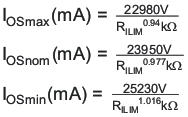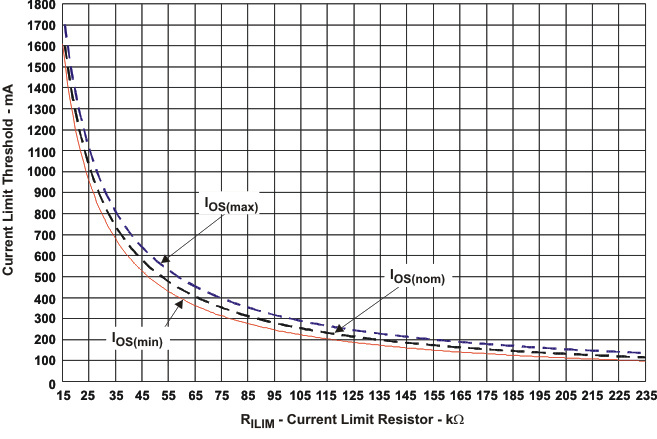SLVSBD0B November 2012 – June 2020 TPS2553-Q1
PRODUCTION DATA.
- 1 Features
- 2 Applications
- 3 Description
- 4 Revision History
- 5 Pin Configuration and Functions
- 6 Specifications
- 7 Parameter Measurement Information
- 8 Detailed Description
-
9 Application and Implementation
- 9.1 Application Information
- 9.2 Typical Applications
- 10Power Supply Recommendations
- 11Layout
- 12Device and Documentation Support
- 13Mechanical, Packaging, and Orderable Information
8.5.1 Programming the Current-Limit Threshold
The overcurrent threshold is user programmable via an external resistor. The TPS2553-Q1 device uses an internal regulation loop to provide a regulated voltage on the ILIM pin. The current-limit threshold is proportional to the current sourced out of ILIM. The recommended resistor range for RILIM is 15 kΩ ≤ RILIM ≤ 232 kΩ to ensure stability of the internal regulation loop. The resistor tolerance should be 1% or better. Many applications require that the minimum current-limit is above a certain current level or that the maximum current-limit is below a certain current level, so it is important to consider the tolerance of the overcurrent threshold when selecting a value for RILIM. The following equations and Figure 22 can be used to calculate the resulting overcurrent threshold for a given external resistor value (RILIM). Figure 22 includes current-limit tolerance due to variations caused by temperature and process. However, the equations do not account for tolerance due to external resistor variation, so it is important to account for this tolerance when selecting RILIM. The traces routing the RILIM resistor to the TPS2553-Q1 device should be as short as possible to reduce parasitic effects on the current-limit accuracy.
RILIM can be selected to provide a current-limit threshold that occurs 1) above a minimum load current or 2) below a maximum load current.
To design above a minimum current-limit threshold, find the intersection of RILIM and the maximum desired load current on the IOS(min) curve and choose a value of RILIM below this value. Programming the current-limit above a minimum threshold is important to ensure start up into full load or heavy capacitive loads. The resulting maximum current-limit threshold is the intersection of the selected value of RILIM and the IOS(max) curve.
To design below a maximum current-limit threshold, find the intersection of RILIM and the maximum desired load current on the IOS(max) curve and choose a value of RILIM above this value. Programming the current-limit below a maximum threshold is important to avoid current-limiting upstream power supplies causing the input voltage bus to droop. The resulting minimum current-limit threshold is the intersection of the selected value of RILIM and the IOS(min) curve.
Current-Limit Threshold Equations (IOS):

where
While the maximum recommended value of RILIM is 232 kΩ, there is one additional configuration that allows for a lower current-limit threshold. The ILIM pin may be connected directly to IN to provide a 75 mA (typical) current-limit threshold. Additional low-ESR ceramic capacitance may be necessary from IN to GND in this configuration to prevent unwanted noise from coupling into the sensitive ILIM circuitry.
 Figure 22. Current-Limit Threshold vs RILIM
Figure 22. Current-Limit Threshold vs RILIM